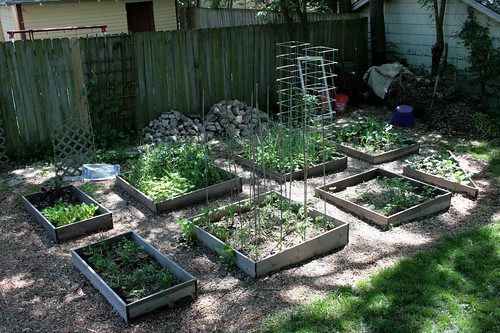
A shot of the garden as it looked earlier today.
It's been nearly a month since I last posted, but things have been busy in the vegetable garden. Since my last post almost everything (save a few herbs) has been planted for spring; the peas are flourishing, and the beans are growing tall; the cabbage plants are starting to develop small heads. There have been quite a few harvests, so I thought I would share some of what I've been eating in roughly the order of each harvest.
Raab, 'Sorrento'
I covered this in my last entry on the first harvest in late April. You can read my thoughts in that entry. The plants have continued to send up stalks since that harvest, but the leaves and heads are much smaller. I attempted to use the whole stalks in a pasta dish one night and, despite blanching and sauteeing them, found them far too tough. Last night I just used the leaves and heads and found them quite tender.
Overall, I'm liking raab (or rabe or rapini, etc.), but I have previously expressed my love of greens. It's definitely more useful in its initial leafy state, although the fact that it continues to produce something edible after that initial harvest is a plus. Another plus I've discovered is that most pests, especially cabbage butterflies, tend to avoid it.

The bok choy and kale together...
Kale, "Improved Dwarf Siberian"
I already knew I liked kale, which is why I decided to plant it this year. The primary advantage of this variety was the (fairly) flat leaves and dwarf size that would presumably tolerate close spacing. Kale must typically grow rather tall, because I estimate the full grown leaves at about a foot. I've had a few bites raw and used this kale in a few stir-fries, and honestly, in terms of flavor, I haven't noted a substantial difference in flavor from the Scotch varieties. If you're like me and dislike the thick, curly leaves of those varieties but like the flavor, this one is worth trying. Another thing I really like about kale is that it grow leaves quickly, so you can do a measured harvest every 1-2 weeks.
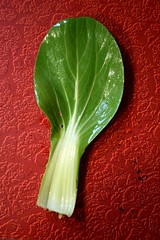
Dwarf Pac Choi, "Ching-Chiang"
I tried some dwarf/baby bok choy from a local grower at the City Market last year and really liked it. The water content in the stalks seems lower than the full-sized varieties, which makes it a bit more flavorful. Also, with the close-spacing I use and only two people to feed, dwarf plants tend to make better sense. The flavor on this variety is good, somewhat similar to cabbage but milder and lighter. I used a couple plants for stir-fry one night and then the remaining four for dinner the next week.
I noted that the cabbage butterflies also avoided the kale and bok choy. For whatever reason, they seem to prefer the brassicaes with the broader, leathery type leaves, i.e. cabbage, broccoli, cauliflower, collards. My theory is that it related to the scent of the leaves.
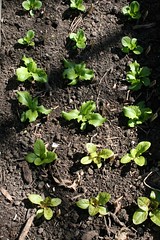
Now on to the lettuce! Since I planted only crisphead and romaine varieties, I had few thinnings to munch on while waiting for the heads to develop. I did experiment a bit and clip a few outer leaves from a couple varieties, apparently to no great detriment to the plants. After a few nibbles of the 'Reine des Glaces,' I decided to back off and let it develop full juicy heads, so I'll just cover the other two varieties I planted.
Romaine/Cos Lettuce, "Flashy Trout's Back" (Organic)
This is an heirloom variety which, absurdly, I just received in this week's CSA share. Like most romaine varieties, this one forms a sturdy head with pale, crisp leaves in the center, but you'll notice from the photo that the outer leaves are quite loose. The spread of the leaves gets to be problematic as they grow, so chances are next year I'll space them a bit further apart. Otherwise, I real like this variety. It's a bit softer than most romaines, in some ways similar to a looseleaf or butterhead variety, but it has more of the bite one expects from a romaine. I've found it pretty adaptable--good with a Mexican salad or a side salad dressed in mustard vinaigrette. The lime green, red-speckled leaves also add some much-needed visual interest.
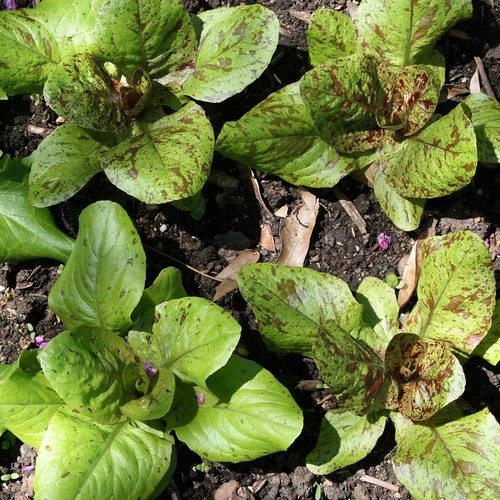
The lovely & interesting leaves of the 'Flashy Trout's Back' lettuce.
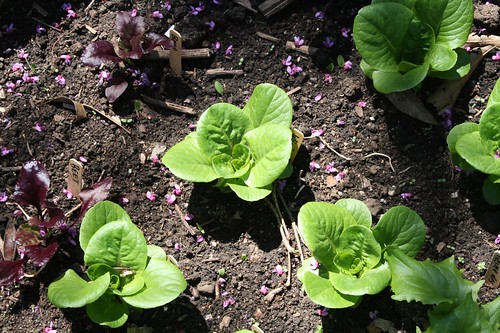
'Winter Density' lettuce beside some young 'Bull's Blood' beets.
Romaine/Cos Lettuce, "Winter Density"
This is, in a lot of ways, just a good basic romaine lettuce, with a nice deep green color and thick, tasty leaves. What I like most about this variety, and what I'd primarily recommend it for, is that it develops small compact heads, not much bigger than 8" high. It's awesome for close spacing and small servings.
The main problem I've been having with my lettuce is snails or slugs munching on the leaves at night. This is a typical problem with lettuce and not one I've made much effort to solve. They've been mostly attacking the outer leaves. And since the rain let up last week, they appear to be less active.
I'm pretty happy with the vegetable garden thus far. One great thing about starting a cool weather garden is that by May you already feel a small sense of accomplishment. In previous years, I've had to wait until June or July for that feeling. While I'm certainly nowhere near where I'd like to be in terms of production, I've still been able to contribute to a meal or two a week for nearly a month now.
Regarding what I've been making, I've been following a lot of recipes from a great book called Serving Up the Harvest, by Andrea Chesman. I'm really still exploring the book, but I love how it's divided according to seasons, along with the selection of basic recipes that can be modified according to what's on hand. If you find yourself online quite a bit, searching for recipes to match whatever's fresh from the garden or market, like I have, it's an extremely useful book.